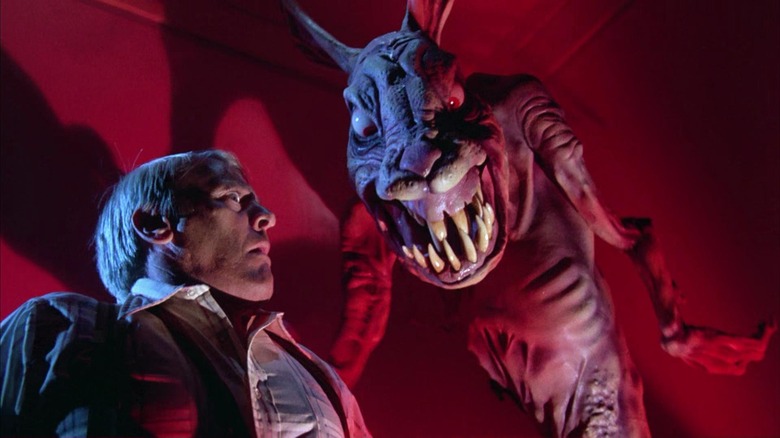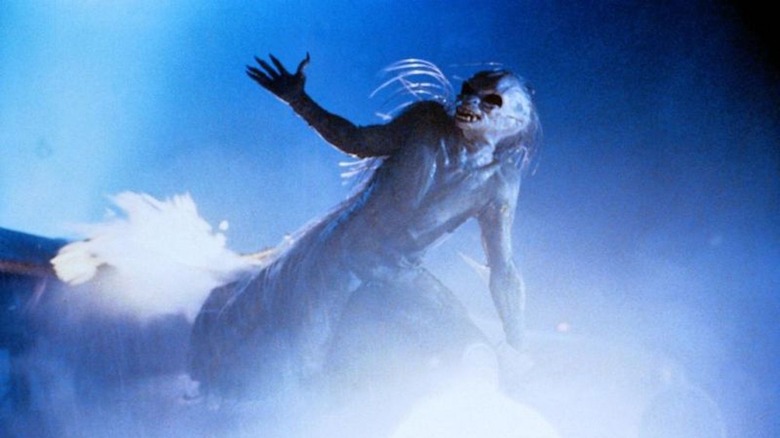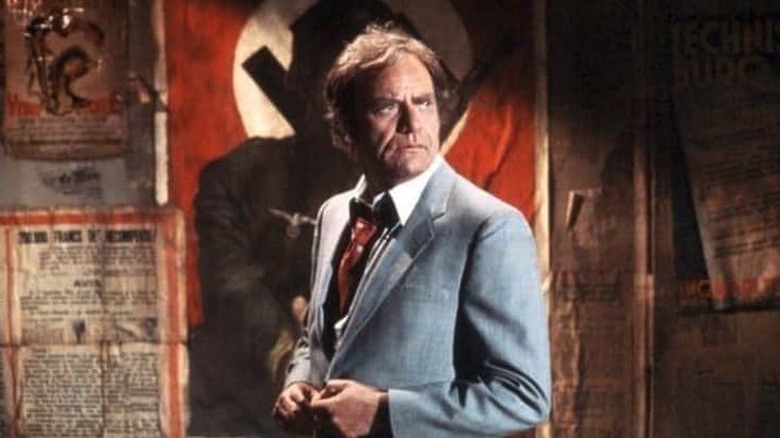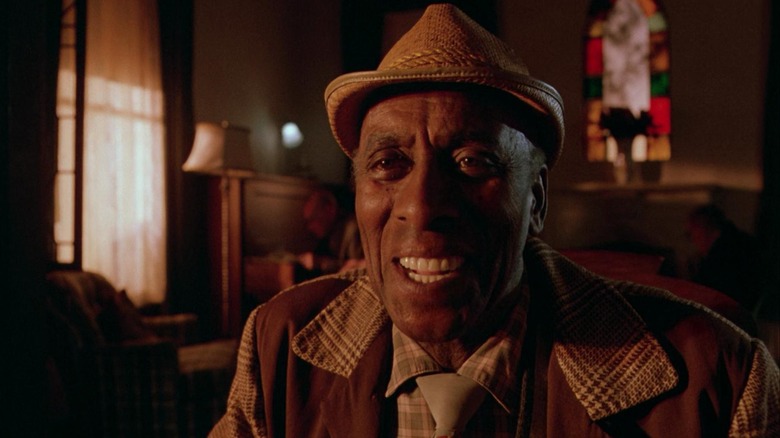Originally, Every Segment In Twilight Zone: The Movie Was Going To Be Interconnected
Anthology movies are often the most frustrating of all film genres. It's incredibly rare to find one where all the stories are equally worth watching, and usually the segments vary considerably in style and quality. For the most part, anthologies are irritatingly patchy affairs, and I always come away wishing some of the weaker entries were cut and the stronger stories much longer.
Just take "Twilight Zone: The Movie." On paper it sounds like an absolute winner: four classic stories from the much-loved TV show remade by two of the hottest directors in Hollywood at the time and two talented up-and-comers. John Landis was fresh from two box office hits, "The Blues Brothers" and "An American Werewolf in London," while Steven Spielberg had enjoyed two back-to-back Best Picture nominees, "Raiders of the Lost Ark" and "E.T. the Extra-Terrestrial."
Landis and Spielberg joined forces to produce "Twilight Zone: The Movie," also accompanied by Joe Dante, who was staking his claim as a new master of the B-movie with "Piranha" and "The Howling;" and George Miller, an impromptu choice who was invited to add a fourth segment after meeting with Spielberg while in the United States for the release of "Mad Max 2."
Despite the filmmaking talent involved, the final movie feels very disjointed, even by anthology standards. But then, the production had suffered one of the most horrific deadly accidents in Hollywood history, which fractured the relationships between the four directors and changed the shape of the film altogether.
So what happens in Twilight Zone The Movie again?
"Twilight Zone: The Movie" starts well with a lively prologue as two guys (Dan Aykroyd and Albert Brooks) chat about the episodes of "The Twilight Zone" they thought were the scariest, before Aykroyd's character pulls out a show-stopping fright of his own. After the promising start and a slick update of the series' title sequence, Landis' main segment is a disappointment.
Vic Morrow doesn't hold anything back as Bill Connor, a bitter racist who finds himself transported to Nazi-occupied France, KKK-country in Alabama, and Vietnam, where he gets to experience virulent racism from the victim's perspective. It's a real chore, and the dark tone is exacerbated by Morrow's dreadful fate while shooting the segment.
Next up is by far the worst, Spielberg's schmaltzy take on "Kick the Can," about a group of elderly residents in an old folks' home reminiscing about their childhoods. On hand is Mr. Bloom (Scatman Crothers), a twinkly old gent who can turn them young again with his magic tin can.
The anthology finally displays signs of life with the arrival of Joe Dante's entry, "It's a Good Life," where Kathleen Quinlan plays a schoolteacher who encounters a young boy with sinister godlike powers. It fades away rather than going out with a bang, but Dante directs with the Looney Tunes flair he would later bring to "Gremlins."
The film signs off with George Miller's electrifying take on "Nightmare at 20,000 Feet," by far the best segment of the bunch. John Lithgow is in great scenery-chewing form as a panicky airline passenger who spots a malevolent creature tearing up the wing of the plane during a heavy thunderstorm.
The fatal helicopter accident
The release of "Twilight Zone: The Movie" was overshadowed by a ghastly helicopter accident that killed Vic Morrow and two child actors, Myca Dinh Le and Renee Shin-Yi Chen. During a nighttime shoot of the Vietnamese scenes for the first segment, a low-flying helicopter was sent spinning out of control by special effects explosions, crashing into the three actors and killing them instantly. Morrow and Myca were both decapitated by the rotor blades.
To make matters worse, the children were hired in violation of California law, their parents paid cash in hand to circumvent restrictions that would have prevented them working at night or around explosions. John Landis and four other defendants, including the pilot, went on trial for involuntary manslaughter. They were eventually acquitted in 1987, despite dodging child labor laws — and serious questions raised about Landis' professional judgment.
The saddest part of the incident is the scene involving the children wasn't in the original script for the segment. It was only added later to redeem Morrow's otherwise completely unsympathetic character by giving him some kids to rescue after being transported to Vietnam. Landis chose to keep the story in the film out of respect to Morrow, but he cut the scene involving the children. His handling of the situation irreparably damaged his relationship with Steven Spielberg, who cut ties with him. Miller was so horrified by the situation he ditched his part of the project in post-production, leaving Dante to oversee his segment's editing.
The accident changed the shape of Twilight Zone: The Movie
The fatal helicopter accident also changed the format of "Twilight Zone: The Movie," which was originally intended to feature overlapping stories. He told the Huffington Post (via Moviefone):
"I remember shooting an ending were Kathleen Quinlan is picked up by Dan Aykroyd. But because of what happened, that ended up getting thrown out and people ended up doing different stories than they were supposed to. And so it became an anthology."
The biggest change of story was Spielberg's, who was deeply affected by the horrific deaths and lost interest in his own segment after the disaster (via "Steven Spielberg: A Biography"). After first toying with the idea of directing an original Halloween-themed story written by Richard Matheson (via Halloween Love), he had chosen instead to remake the old "Twilight Zone" episode called "The Monsters Are Due on Maple Street." However, both stories would have required permits for child actors to work outside at nighttime, something which Spielberg had little appetite for after the helicopter incident.
Spielberg switched to the sentimental "Kick the Can" after trying to cancel the whole project. The lawyers at Warner Bros. were concerned that would look like an admission of guilt, and persuaded him to fulfill his obligations to the film.
It's an eerie experience watching "Twilight Zone: The Movie" again knowing about the terrible death of Morrow and the two children, certainly not eerie in the way you'd want a "Twilight Zone" film to feel. As Joe Dante summed up: "It's not 'Schindler's List' — it's not worth dying for. No movie is worth that."



